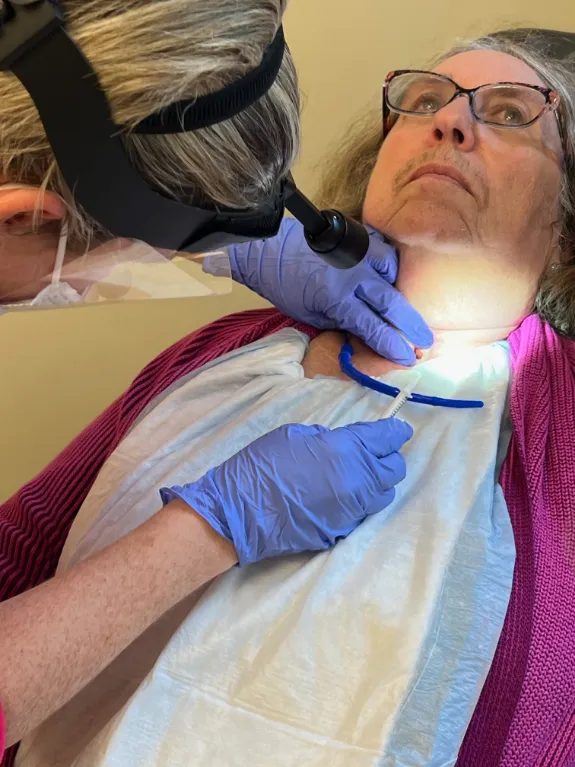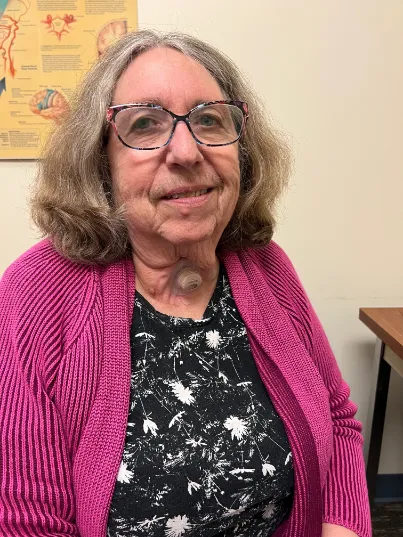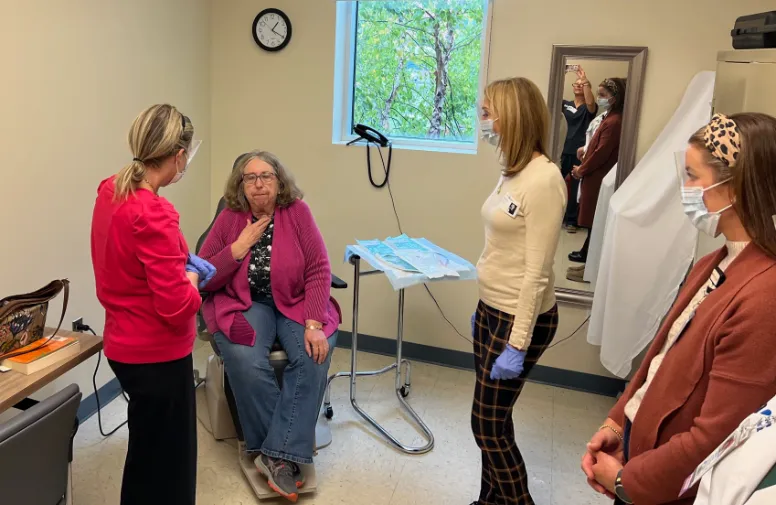A few weeks ago, my SLP asked me if I would be willing to take part in a hands-on training for SLPs in changing TEPs in our local clinic. This is what happened
A Decision to Embrace Change (pun intended)
My SLP, Mary Ell Izzo, explained that the training would be done and supervised by ATOS staff and that there would be no charge to me for the change. As a bonus there would be an opportunity for some one-on-one support in the use of the Hands-Free device.
(ATOS is one of two main suppliers of laryngectomy supplies, the other is InHealth)
Despite having had a rough change on one of my times, after thinking a bit I decided to say yes. To me, the SLPs who are devoted to our needs are the true unsung heroes of our recovery and continued quality of life. Our surgeons may make a diagnosis and perform the life saving operations that we need BUT the day to day is clearly the special work of our SLPs and ENTs.
An Inspiring Training Experience
The afternoon came, and I arrived a few minutes early to be sure that no one had to wait for me! When I went into the treatment room it was filled with women who were there to put their collective skills, ideas, and discoveries into action to improve my voicing experience and to update the skills of the SLPs who are part of our clinic. It was a humbling experience for sure.
Precision in the Procedure
After a few minutes of conversation going over my history and explaining exactly what was to take place we got started. I felt confident and well taken care of as the exam and procedure began. My stoma is a bit floppy and it makes it somewhat difficult to visualize my TEP and puncture. After a bit of working to get light, everyone was able to take a look and make their observations and opinions known.

Choosing the Right Size TEP
The removal went smoothly as did the insertion of the dilator. The TEP was looked at, and I was given praise for taking care of it so well. Then the conversation about the size and length of the device ensued. I had gone up in size at the last change and had been happy with no leaking for 7 months.
The Art of Proper Fit
Measuring is critical to proper fit, and this was clearly going to be carefully done and well explained to all those being trained. So dilator out and sizing in, which proved to be a bit more of a challenge. Everyone had a turn looking, and the question of 8 (old size) or 10 went around the room. Finally, agreement was had at going with the 10.
Mastering the Technique
Dilation back in place, the TEP was prepped for insertion, and a good discussion was had about techniques for placement, options for ease of insertion, and proper fit, and what to do if things don’t go smoothly.
For me, it was fascinating to hear so many ideas of how to make this easier for the patient and for the SLP. Options for angle of approach, depth of placement, and how to be sure that the gel cap stays on going in, all were covered.
Persistence and Success
And then the trainee attempted placement. Unfortunately, no success with the first try. I had told my SLP that my tolerance was going to be 3 tries and then please, a switch to be sure it was okay on the 4th. I was hoping that 2 would be the best result. After a few minutes for everyone to regroup, the ATOS trainer provided some more support and suggestions, and boom, in it went. Everyone looked and agreed that success had taken place.

The Quest for Voice
The protocol is to have voice at that point with manual occlusion, something that I have never been able to do. After a few moments of gesturing and my SLP going “she has never been successful with this,” we agreed that all looked perfect, and testing with a baseplate and HME would be okay.
New Approaches and Options
The SLP who had been with me for the unfortunate 5 tries before the successful experience was excited to learn a new approach that worked for my anatomy and could help things go smoothly moving forward on future changes. I now felt that there were options for me on who can do a change with me feeling confident and comfortable.
Embracing Hands-Free Voicing
So on to the bonus of working on Hands-Free voicing. I have been struggling for a few months with the device never getting any voice at all and being super frustrated about it. I had about given up on that being an option for me despite my huge desire to be able to use it for teaching when having two hands for demonstrating is helpful.
Discovering the Stabilibase
The first revelation was the Stabilibase. I had looked at them and thought they are too big and will not work for me. BUT imagine my surprise when I put one on and not only did it fit smoothly, go on easily, but it opened up my Stoma in a way that improved my breathing as well as my voicing. Everyone was happy that I could get a clear voice in seconds with the standard HME.
Overcoming Challenges with Hands-Free Voicing
So out came my Hands-Free, we inserted a new HME, practiced the turning of the device to provide the options for manual or hands-free occlusion. I have a lot of left/right perception issues, so it was a bit of a challenge to get the communication organized on how to turn it. Once that was sorted, I tried to speak. Absolutely nothing happened just like at home.
A Defective Device and a Bright Solution
The ATOS trainer looked puzzled and then said let’s try another device. She explained the different strengths of the membrane and that perhaps, trying the light instead of the medium would help. So, we did, and within seconds I was speaking with little effort! The sensation of the membrane closing takes some getting used to at the start, but then the excitement of just talking with no hands involved took over. She looked at my device and declared it defective; it was not me, it was it!
Looking Forward
Looking back at the afternoon, I cannot express enough thankfulness for the efforts of all of the participants in supporting my voicing journey. I do not take for granted my newfound ability to communicate with a voice.
The Power of Voice
As I began the work of recovery, speech was at the heart of my concerns. To me, the actual quality of the voice was secondary to being able to voice at all and to be understood.
When I was In the hospital for my laryngectomy, the SLPs and the SLP students worked with me to develop my confidence in using the TEP and the EL so that I had options. I practiced by reading aloud to myself and speaking to anyone who came into my room even if I wasn’t totally successful.
On the day I left the hospital after 14 days of isolation (Covid made visitors impossible) I got into the car and said hello to my husband and a good friend. Tears all around!
Encouraging Others to Say “Yes”
This training experience was similar to me as a time when I could give back to the community of SLPs and to bring them an opportunity to see and feel what changing is all about. Having the focus of so much talent totally on my Voice journey was a unique privilege, and I encourage anyone who is asked to step up to say Yes! You will be helping to keep the skills of SLPs up to date and providing the way forward for other patients to have good experiences.
Cooperative Dedication
The dedication of the ATOS staff was so obvious, they were generous in sharing knowledge with everyone and also were keen to listen to the others for ideas and questions from their practices. It does take cooperation of so many for us to live our best lives, free to go about our daily interactions with confidence and grace.

A Thrilling New Voicing Option
For me having another option for Voicing is thrilling, and as I practice and develop this skill, I will forever remember the kindness of the SLPs, the ATOS reps, and those being trained.
Lary’s Speakeasy has a nationwide listing of SLPs here. If you are an SLP that wishes to be listed, see our Contact Us page.
Brooke Elkan-Moore lives in the beautiful Hudson Valley with her Newfoundland Dahlia.
She is a photographer, writer and devoted gardener. A Larry since January of 2021,
Brooke has embraced her changed life and continues to take on new challenges.


Thank you for doing this. You are helping the next generation of SLPs